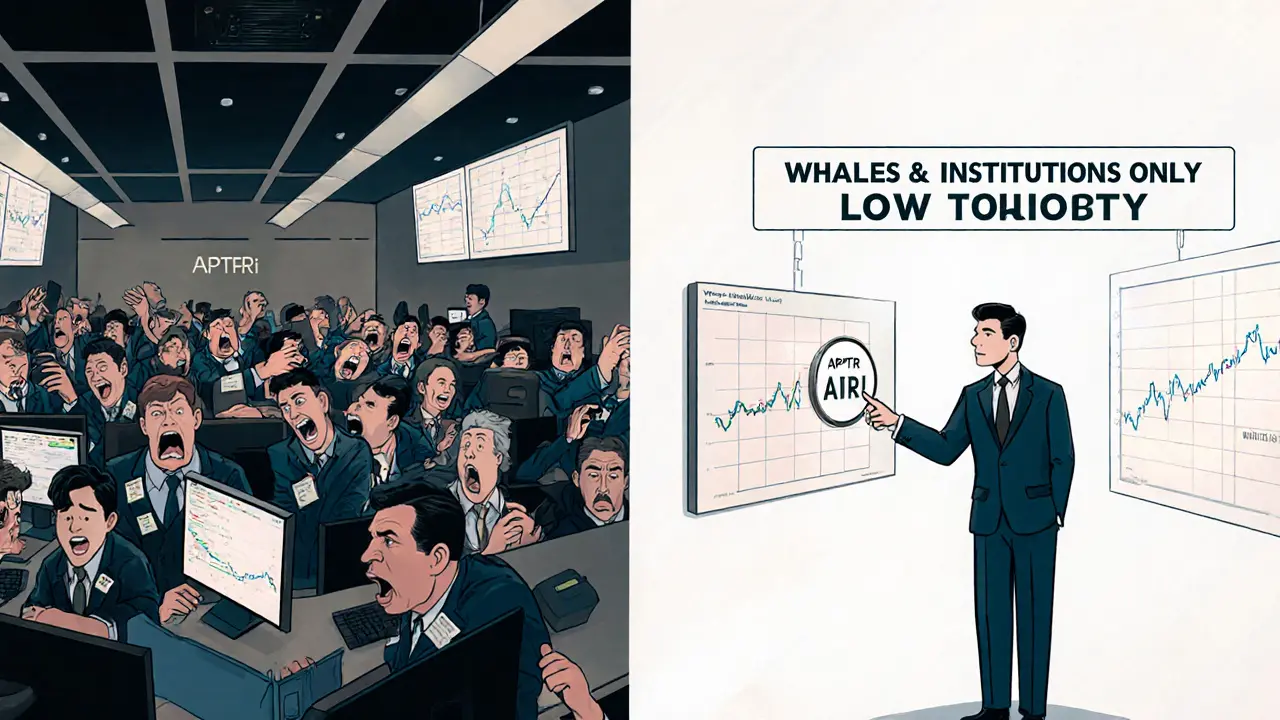APTR Slippage Calculator
Calculate Your Trade Impact
APTR's trading volume is extremely low ($28.96 24h). This calculator shows how much slippage you might experience when trading.
Warning: APTR has very low liquidity (only $28.96 daily volume). Large trades can cause significant price movement. This is not financial advice.
Aperture Finance (APTR) is a crypto project built to make decentralized finance simpler - especially for people who find DeFi too complicated. Launched in May 2024, it’s not another meme coin or copycat DeFi platform. Instead, it’s trying to solve a real problem: why does using DeFi feel like doing your taxes on a smartphone? The answer, according to Aperture Finance, is artificial intelligence.
What APTR actually does
Aperture Finance’s main product is called Intents. Think of it like a smart assistant for blockchain transactions. Instead of manually setting up liquidity pools, adjusting price ranges, or tracking multiple wallets across chains, you tell the system what you want - like ‘buy $5,000 worth of ETH over the next 24 hours at the best average price’ - and the AI handles the rest. It uses algorithms like TWAP and VWAP to break big trades into small chunks, avoiding price spikes that hurt retail traders.
This isn’t just convenience. In traditional DeFi platforms like Uniswap V3, managing liquidity positions takes hours of monitoring. ApertureSwap, their built-in DEX, automates that. It’s built on Manta Pacific, a privacy-focused Ethereum sidechain, and lets users place limit orders and range-based liquidity positions with one click. No more constant recalculations. No more missed opportunities because you were asleep.
How APTR works as a token
APTR is an ERC-20 token on Ethereum. That means it’s compatible with most wallets and DeFi tools you already use. The total supply is 1 billion tokens, but only about 90.9 million are in circulation as of late 2024. The rest are locked up - 20% for the team and advisors, with a 9-month cliff and 24-month vesting. Another 37% is reserved for the ecosystem fund, meant to grow the platform over time.
The token was distributed through three funding rounds totaling $5.3 million. Early investors paid as little as $0.015 per APTR. By the public sale, the price had jumped to $0.045. That’s a big increase - but remember, early buyers got their tokens at a fraction of today’s price. The airdrop accounted for 7% of supply, and only 1% went to the public sale. That means most APTR holders are either insiders or institutional players.
Who’s using it - and who isn’t
Aperture Finance isn’t trying to appeal to everyone. Their website explicitly mentions a ‘Whales & Institutions’ service for investors planning to put in over $100,000. That’s unusual. Most DeFi projects beg for retail users. Aperture is targeting hedge funds, family offices, and crypto funds that need to move large amounts without crashing the market.
But here’s the catch: retail users are struggling to use it. As of November 2024, APTR is only listed on two exchanges: Gate.io and HTX. That’s it. No Binance, no Coinbase, no Kraken. If you don’t already have an account on one of those, buying APTR means jumping through hoops - transferring funds, verifying identity, waiting for approval. And even then, the trading volume is tiny. CoinGecko reports just $28.96 traded in 24 hours. That’s less than what some people spend on coffee in a week.
Low volume means slippage. If you try to buy $1,000 worth of APTR, the price could move against you before your order fills. That’s why experts warn: this isn’t a coin for casual investors. It’s a high-risk bet on a team’s promise, not a proven product.

Price predictions: hope vs. reality
Some websites predict APTR will hit $0.002 by 2025. Others say $0.0019 by 2026. A few even suggest it could reach $0.0026 by 2030. Those numbers sound impressive - until you check the math. At $0.002, APTR’s market cap would be $2 million. That’s still 13 times smaller than its current $155,000 market cap. For that to happen, adoption would need to explode overnight.
But here’s the problem: no one’s talking about it. Reddit has almost no APTR threads. Twitter discussions are sparse. There are no YouTube tutorials. The only real user feedback comes from a single Gate.io forum post from June 2024, where someone said the ‘1-click experience’ worked - but there weren’t enough token pairs to trade meaningfully. That’s not a sign of momentum. That’s a sign of stagnation.
How Aperture compares to bigger DeFi players
Compare Aperture to MakerDAO or Aave. MakerDAO has a $3.2 billion market cap. Aave has $1.1 billion. They’ve been around for years. They have thousands of active users. They’re integrated into dozens of wallets and apps. Aperture? $155,000 market cap. Two exchanges. Almost no community. Its AI features are interesting, but if no one can use them, they don’t matter.
Aperture’s biggest advantage is its focus on institutional tools. Most DeFi platforms ignore large investors because they’re harder to serve. Aperture tries to fill that gap. But that’s also its biggest weakness. If institutions don’t adopt it, and retail users can’t access it, Aperture is stuck in a vacuum.

Is APTR worth buying?
If you’re looking for a quick flip, maybe. The price jumped 27% in 24 hours at one point. That’s the kind of volatility that attracts speculators. But if you’re thinking long-term, ask yourself: what’s the real use case?
Right now, APTR doesn’t have one. The platform promises AI-driven DeFi, but without liquidity, without listings, without users, it’s just a whitepaper with a token attached. The team raised $5.3 million - that’s real money. But money doesn’t build products. People do.
Aperture Finance could become something big. It has the tech. It has the funding. It has the right idea. But right now, it’s a prototype with no customers. That’s not a crypto coin. That’s a gamble.
What’s next for Aperture Finance?
The roadmap says they’re working on cross-chain expansion beyond Manta Pacific. They plan to add more blockchains in 2025. That’s good. They also say they’re doubling down on AI innovation. That’s promising. But without listing on major exchanges like Binance or Coinbase, none of that matters to most people.
If Aperture gets listed on one big exchange in 2025, the price could spike. If they launch a major partnership with a hedge fund or institutional wallet provider, adoption might follow. But those are big ifs. Right now, there’s no evidence they’re happening.
For now, APTR remains a niche project with high risk and low liquidity. It’s not for beginners. It’s not for casual investors. It’s for people who understand DeFi deeply, can tolerate extreme volatility, and are willing to bet on a team that hasn’t yet proven it can deliver.
What is APTR crypto?
APTR is the native token of Aperture Finance, a DeFi platform launched in May 2024 that uses AI to simplify complex blockchain transactions. It’s an ERC-20 token on Ethereum with a total supply of 1 billion, and around 90.9 million currently in circulation. APTR powers access to the platform’s AI-driven trading tools and liquidity automation features.
Where can I buy APTR coin?
As of November 2024, APTR is only available on two exchanges: Gate.io and HTX. It’s not listed on major platforms like Binance, Coinbase, or Kraken. To buy it, you’ll need to create an account on one of those exchanges, deposit funds, and trade for APTR directly. Due to low liquidity, even small trades can cause significant price swings.
Is Aperture Finance safe to use?
The platform’s smart contracts haven’t been publicly audited by major firms like CertiK or SlowMist, which is a red flag. While the team claims to be backed by Silicon Valley veterans, there’s no public proof of their track record. Use at your own risk. Never invest more than you can afford to lose, especially since the project has minimal user adoption and trading volume.
Why is APTR’s trading volume so low?
APTR’s 24-hour trading volume is around $28.96, according to CoinGecko. That’s extremely low for a token with a $155,000 market cap. The reason? Limited exchange listings, no marketing, and no community traction. Most people don’t know about it, and those who do can’t easily trade it. Low volume makes it risky - even small buys or sells can cause big price swings.
Can Aperture Finance compete with Aave or MakerDAO?
Not right now. Aave and MakerDAO have billions in market cap, thousands of users, and integrations across dozens of wallets and apps. Aperture Finance has a market cap under $200,000, two exchange listings, and almost no public discussion. Its AI tools are promising, but without adoption, scale, or liquidity, it’s not a competitor - it’s a speculative experiment.
What’s the long-term potential of APTR?
The long-term potential depends entirely on execution. If Aperture Finance gets listed on Binance, partners with institutional investors, and delivers on its AI promises, APTR could grow. But if it stays stuck on Gate.io with $30 in daily volume, it will fade into obscurity. Right now, there’s no clear path to mainstream adoption. The tech is interesting, but the market hasn’t voted yet.
